Ultrafast & Terahertz Photonics: Publications
Filter by PI:
Filter by topic:
Graphene controlled Brewster angle device for ultra broadband terahertz modulation
Z. Chen, X. Chen, L. Tao, K. Chen, M. Long, K. Yan, R.I. Stantchev, E. Pickwell-MacPherson & J.-B. Xu
Nature Communications 9 4909 (November 2018) [ pdf ] [ ref ]
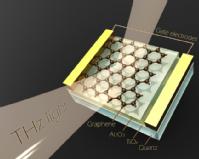
Terahertz modulators with high tunability of both intensity and phase are essential for effective control of electromagnetic properties. Due to the underlying physics behind existing approaches there is still a lack of broadband devices able to achieve deep modulation. Here, we demonstrate the effect of tunable Brewster angle controlled by graphene, and develop a highly-tunable solid-state graphene/quartz modulator based on this mechanism. The Brewster angle of the device can be tuned by varying the conductivity of the graphene through an electrical gate. In this way, we achieve near perfect intensity modulation with spectrally flat modulation depth of 99.3 to 99.9 percent and phase tunability of up to 140 degree in the frequency range from 0.5 to 1.6 THz. Different from using electromagnetic resonance effects (for example, metamaterials), this principle ensures that our device can operate in ultra-broadband. Thus it is an effective principle for terahertz modulation.
The Effects of Doping Density and Temperature on the Optoelectronic Properties of Formamidinium Tin Triiodide Thin Films
R. L. Milot, M. T. Klug, C. L. Davies, Z. Wang, H. Kraus, H. J. Snaith, M. B. Johnston, and L. M. Herz
Advanced Materials (Sept 2018) [ pdf ] [ ref ]
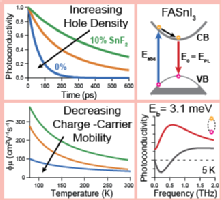 Optoelectronic properties are unraveled for formamidinium tin triiodide (FASnI3) thin films, whose background hole doping density is varied through SnF2 addition during film fabrication. Monomolecular charge‐carrier recombination exhibits both a dopant‐mediated part that grows linearly with hole doping density and remnant contributions that remain under tin‐enriched processing conditions. At hole densities near 1020 cm−3, a strong Burstein–Moss effect increases absorption onset energies by ≈300 meV beyond the bandgap energy of undoped FASnI3 (shown to be 1.2 eV at 5 K and 1.35 eV at room temperature). At very high doping densities (1020 cm−3), temperature‐dependent measurements indicate that the effective charge‐carrier mobility is suppressed through scattering with ionized dopants. Once the background hole concentration is nearer 1019 cm−3 and below, the charge‐carrier mobility increases with decreasing temperature according to ≈T−1.2, suggesting that it is limited mostly by intrinsic interactions with lattice vibrations. For the lowest doping concentration of 7.2 × 1018 cm−3, charge‐carrier mobilities reach a value of 67 cm2 V−1 s−1 at room temperature and 470 cm2 V−1 s−1 at 50 K. Intraexcitonic transitions observed in the THz‐frequency photoconductivity spectra at 5 K reveal an exciton binding energy of only 3.1 meV for FASnI3, in agreement with the low bandgap energy exhibited by this perovskite.
Optoelectronic properties are unraveled for formamidinium tin triiodide (FASnI3) thin films, whose background hole doping density is varied through SnF2 addition during film fabrication. Monomolecular charge‐carrier recombination exhibits both a dopant‐mediated part that grows linearly with hole doping density and remnant contributions that remain under tin‐enriched processing conditions. At hole densities near 1020 cm−3, a strong Burstein–Moss effect increases absorption onset energies by ≈300 meV beyond the bandgap energy of undoped FASnI3 (shown to be 1.2 eV at 5 K and 1.35 eV at room temperature). At very high doping densities (1020 cm−3), temperature‐dependent measurements indicate that the effective charge‐carrier mobility is suppressed through scattering with ionized dopants. Once the background hole concentration is nearer 1019 cm−3 and below, the charge‐carrier mobility increases with decreasing temperature according to ≈T−1.2, suggesting that it is limited mostly by intrinsic interactions with lattice vibrations. For the lowest doping concentration of 7.2 × 1018 cm−3, charge‐carrier mobilities reach a value of 67 cm2 V−1 s−1 at room temperature and 470 cm2 V−1 s−1 at 50 K. Intraexcitonic transitions observed in the THz‐frequency photoconductivity spectra at 5 K reveal an exciton binding energy of only 3.1 meV for FASnI3, in agreement with the low bandgap energy exhibited by this perovskite.
Efficient Intraband Hot Carrier Relaxation in the Perovskite Semiconductor Cs1-xRbxSnI3 Mediated by Strong Electron-Phonon Coupling
M. Monti, S. Tao, M. Staniforth, A. Crocker, E. Griffin, A. Wijesekara, R.A. Hatton, and J. Lloyd-Hughes
J. Phys. Chem. C 122 20669 (Aug 2018) [ pdf ] [ ref ]
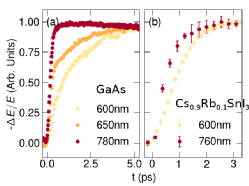 The dynamic increase in THz photoconductivity resulting from energetic intraband relaxation was used to track the formation of highly mobile charges in thin films of the tin iodide perovskite Cs1-xRbxSnI3, with x=0 and x=0.1. Energy relaxation times were found to be around 500fs, comparable to those in the prototypical inorganic semiconductor GaAs. At low excess energies the efficient intraband energy relaxation in the lowest conduction and valence bands of Cs1-xRbxSnI3 can be understood within the context of the Fröhlich electron-phonon interaction, with a strong coupling strength. For higher excess energies the photoconductivity rise time lengthens in accordance with carrier injection into multiple bands, identified by quantitative first-principles bandstructure calculations and photoluminescence spectroscopy. The findings contribute to the development of design rules for photovoltaic devices capable of extracting hot carriers from perovskite semiconductors.
The dynamic increase in THz photoconductivity resulting from energetic intraband relaxation was used to track the formation of highly mobile charges in thin films of the tin iodide perovskite Cs1-xRbxSnI3, with x=0 and x=0.1. Energy relaxation times were found to be around 500fs, comparable to those in the prototypical inorganic semiconductor GaAs. At low excess energies the efficient intraband energy relaxation in the lowest conduction and valence bands of Cs1-xRbxSnI3 can be understood within the context of the Fröhlich electron-phonon interaction, with a strong coupling strength. For higher excess energies the photoconductivity rise time lengthens in accordance with carrier injection into multiple bands, identified by quantitative first-principles bandstructure calculations and photoluminescence spectroscopy. The findings contribute to the development of design rules for photovoltaic devices capable of extracting hot carriers from perovskite semiconductors.
Highly Sensitive Terahertz Thin-Film Total Internal Reflection Spectroscopy Reveals in Situ Photoinduced Structural Changes in Methylammonium Lead Halide Perovskites
Q. Sun, X. Liu, J. Cao, R.I. Stantchev, Y. Zhou, X. Chen, E.P.J. Parrott, J. Lloyd-Hughes, N. Zhao, and E. Pickwell-MacPherson
J. Phys. Chem. C 122 17552 (June 2018) [ pdf ] [ ref ]
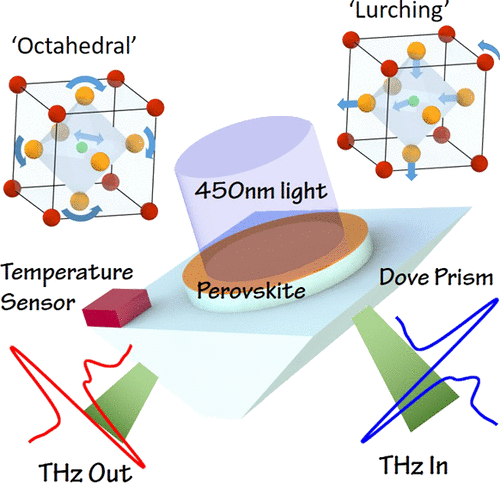
Terahertz (THz) thin-film total internal reflection (TF-TIR) spectroscopy is shown to have an enhanced sensitivity to the vibrational properties of thin films in comparison with standard THz transmission spectroscopy. This increased sensitivity was used to track photoinduced modifications to the structure of thin films of methylammonium (MA) lead halide, MAPbI3–xBrx (x = 0, 0.5, 1, and 3). Initially, illumination strengthened the phonon modes around 2 THz, associated with Pb–I stretch modes coupled to the MA ions, whereas the 1 THz twist modes of the inorganic octahedra did not alter in strength. Under longer term illumination, the 1 THz phonon modes of encapsulated films slowly reduced in strength, whereas in films exposed to moisture and oxygen, these phonons weaken more rapidly and blue-shift in frequency. The rapid monitoring of environmentally induced changes to the vibrational modes afforded by TF-TIR spectroscopy offers applications in the characterization and quality control of the perovskite thin-film solar cells and other thin-film semiconductors.
Cs1−xRbxSnI3 light harvesting semiconductors for perovskite photovoltaics
K.P. Marshall, S. Tao, M. Walker, D.S. Cook, J. Lloyd-Hughes, S. Varagnolo, A. Wijesekara, D. Walker, R.I. Walton and R.A. Hatton
Materials Chemistry Frontiers 2:1515 (June 2018) [ pdf ] [ ref ]
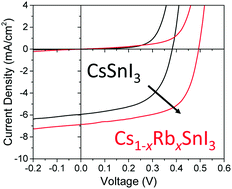
We show that films of the 3-dimensional perovskite Cs1−xRbxSnI3 can be prepared from room temperature N,N-dimethylformamide solutions of RbI, CsI and SnCl2 for x ≤ 0.5, and that for x ≤ 0.2 film stability is sufficient for utility as the light harvesting layer in inverted photovoltaic (PV) devices. Electronic absorption and photoluminescence spectroscopy measurements supported by computational simulation, show that increasing x increases the band gap, due to distortion of the lattice of SnI6 octahedra that occurs when Cs is substituted with Rb, although it also reduces the stability towards decomposition. When Cs0.8Rb0.2SnI3 perovskite is incorporated into the model inverted PV device structure; ITO|perovskite|C60|bathocuproine|Al, an ∼120 mV increase in open-circuit is achieved which is shown to correlate with an increase in perovskite ionisation potential. However, for this low Rb loading the increase in band gap is very small (∼30 meV) and so a significant increase in open circuit-voltage is achieved without reducing the range of wavelengths over which the perovskite can harvest light. The experimental findings presented are shown to agree well with the predictions of density functional theory (DFT) simulations of the stability and electronic structure, also performed as part of this study.
Conduction properties of thin films from a water soluble carbon nanotube/hemicellulose complex
D. Shao, P. Yotprayoonsak, V. Saunajoki, M. Ahlskog, J. Virtanen, V. Kangas, A. Volodin, C. Van Haesendonck, M. Burdanova, C. D. W. Mosley and J. Lloyd-Hughes
Nanotechnology 29 145203 (Feb 2018) [ pdf ] [ ref ]
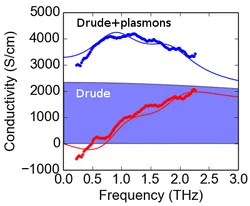 We have examined the conductive properties of a carbon nanotube (CNT) based thin film, which were prepared via dispersion in water by non-covalent functionalization of the nanotubes with xylan, a type of hemicellulose. Measurements of low temperature conductivity, Kelvin Probe Force Microscopy, and high frequency (THz) conductivity elucidated the intra-tube and inter-tube charge transport processes in this material. The measurements show excellent conductive properties of the as prepared thin films, with bulk conductivity up to 2000 S/cm. The transport results demonstrate that the hemicellulose does not seriously interfere with the inter-tube conductance.
We have examined the conductive properties of a carbon nanotube (CNT) based thin film, which were prepared via dispersion in water by non-covalent functionalization of the nanotubes with xylan, a type of hemicellulose. Measurements of low temperature conductivity, Kelvin Probe Force Microscopy, and high frequency (THz) conductivity elucidated the intra-tube and inter-tube charge transport processes in this material. The measurements show excellent conductive properties of the as prepared thin films, with bulk conductivity up to 2000 S/cm. The transport results demonstrate that the hemicellulose does not seriously interfere with the inter-tube conductance.
Tracking a hysteretic and disorder-broadened phase transition via the electromagnon response in improper ferroelectrics
C. D. W. Mosley, D. Prabhakaran and J. Lloyd-Hughes
J. Phys. D: Applied Physics 51 084002 (Jan 2018) [ pdf ][ ref ]
We demonstrate that 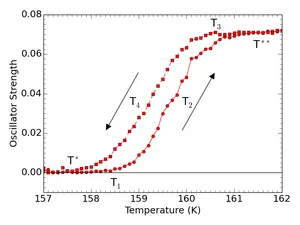 electromagnons can be used to directly probe the nature of a phase transition between magnetically ordered phases in an improper ferroelectric. The antiferromagnetic/paraelectric to antiferromagnet/ferroelectric phase transition in Cu1-xZnxO (x = 0, 0.05) alloys was tracked via the electromagnon response using terahertz time-domain spectroscopy, on heating and cooling through the phase transition. The transition was found to exhibit thermal hysteresis, confirming its first-order nature, and to broaden under the influence of spin-disorder upon Zn substitution. The energy of the electromagnon increases upon alloying, as a result of the non-magnetic ions modifying the magnetic interactions that give rise to the multiferroic phase and electromagnons. We describe our findings in the context of recent theoretical work that examined improper ferroelectricity and electromagnons in CuO from phenomenological and first-principles approaches.
electromagnons can be used to directly probe the nature of a phase transition between magnetically ordered phases in an improper ferroelectric. The antiferromagnetic/paraelectric to antiferromagnet/ferroelectric phase transition in Cu1-xZnxO (x = 0, 0.05) alloys was tracked via the electromagnon response using terahertz time-domain spectroscopy, on heating and cooling through the phase transition. The transition was found to exhibit thermal hysteresis, confirming its first-order nature, and to broaden under the influence of spin-disorder upon Zn substitution. The energy of the electromagnon increases upon alloying, as a result of the non-magnetic ions modifying the magnetic interactions that give rise to the multiferroic phase and electromagnons. We describe our findings in the context of recent theoretical work that examined improper ferroelectricity and electromagnons in CuO from phenomenological and first-principles approaches.
